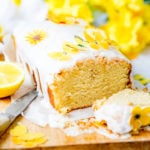Vegan Lemon Drizzle Cake Recipe
This lemon drizzle cake is so fluffy, zingy and delicious! Drizzled with lemon icing and topped sugar paper flowers it makes a fantastic Easter cake!
Servings: 12 servings
Ingredients
Cake:
- 75 ml (1/4 cup + 1 tsp) vegetable oil
- 200 g (1 cup) caster (or superfine granulated) sugar
- zest of 1 lemon (about 1 tbsp)
- 250 g (2 cups + 1 tsp) plain (all-purpose) flour
- 1 tsp bicarbonate of soda
- 1 pinch salt
- 220 ml (1 cup minus 1 tbsp) soya (soy) milk
- juice of half a lemon (about 1 tbsp)
Drizzle
- 2 tbsp caster sugar
- juice of 1 lemon (about 2 tbsp)
Icing:
- 200 g (1 2/3 cups) icing (confectioners') sugar sifted
- juice of 1 lemon (about 2 tbsp)
Also
- rice paper flowers and/or butterflies
Instructions
- Preheat the oven to 170C/325F (fan). Line a loaf tin with a loaf liner.
- Mix the vegetable oil and sugar together in a large bowl. Add in the lemon zest, flour, bicarbonate of soda, salt, and milk. Beat together with a wooden spoon to combine. Stir in the lemon juice.75 ml (1/4 cup + 1 tsp) vegetable oil, 200 g (1 cup) caster (or superfine granulated) sugar, zest of 1 lemon, 250 g (2 cups + 1 tsp) plain (all-purpose) flour, 1 tsp bicarbonate of soda, 1 pinch salt, 220 ml (1 cup minus 1 tbsp) soya (soy) milk, juice of half a lemon
- Spoon into the prepared loaf tin and place in the oven for 35-45 minutes until golden and cooked through (you can test this by inserting a metal skewer into the centre of the cake – if it’s cooked, it should come out clean).
- Take it out of the oven. Mix together the caster sugar and 2 tbsp of lemon juice. Poke several holes in the hot cake and spoon over the sugar-lemon mixture. Leave to cool in the tin. This first topping adds a more intense lemony flavour and moisture to the cake.2 tbsp caster sugar, juice of 1 lemon
- Once cool, remove from the tin and remove the loaf liner.
- Place the icing sugar in a bowl and add 2 tbsp of lemon juice. Stir with a whisk until combined. You may need to add a little more lemon juice if you want a thinner drizzle.200 g (1 2/3 cups) icing (confectioners') sugar, juice of 1 lemon
- Spoon the icing mixture over the cake. Arrange rice paper flowers and butterflies on top.rice paper flowers and/or butterflies
- Cut into slices and serve.
Video
Notes
Bicarbonate of Soda:
This recipe uses bicarb, but there's a mistake on the wording of the video - saying 'baking powder' instead. Baking powder will still work (you may find there's just slightly less rise), so don't worry if you used baking powder instead of bicarb.Lemon juice:
I find it's best to use fresh lemon juice for the best flavour.Don't be tempted to add more lemon juice to the cake mixture though, as the acid in the lemon reacts with the alkaline in the bicarbonate of soda. The amount in the recipe is enough to give a nice rise to the cake with a fluffy texture. Too much lemon juice (or bicarbonate of soda) can cause too many bubbles to form in the mixture, which will cause the cake to rise too fast. The cake may then sink as the uncooked batter can't support the bubbles. .
The skewer test:
It's really important to test that the cake is done with a metal or wooden skewer, as this cake can look browned and 'done', but still be uncooked in the middle. Insert a skewer into the middle of the cake. If it comes out clean, it's done. If it comes out with raw cake mixture on it, place back in the oven for 5 minutes, then test again. Repeat until fully cooked (you can place foil on the cake if it starts to look too brown). .Can I make it ahead?
Yes. Once the icing has set, placing in an airtight container at room temperature, and it will keep for approx. 3 days. .Can I freeze it?
Yes, drizzle on the sugar-lemon mixture, but NOT the icing. Then cool, wrap in foil and freeze for up to a month. Defrost in the refrigerator, and once defrosted, drizzle on the icing before serving. .Can I make it with regular milk?
Yes, you can replace the soya milk with regular semi-skimmed (half-fat) or full fat milk. Of course it won't be vegan any more then. .Can I make it gluten free?
I haven't tried to make a gluten free version of this, but I have a great recipe for a gluten free orange drizzle cake (not vegan). .Can I make it with lime or grapefruit instead?
Yes, for a lime version, simple replace the lemon with the same quantity of lime. For a grapefruit version, try this vegan grapefruit drizzle cake I did for Neff. . Nutritional information is per slice.Nutrition
Calories: 279kcal | Carbohydrates: 53g | Protein: 2g | Fat: 6g | Saturated Fat: 5g | Sodium: 18mg | Sugar: 35g
QR code
Scan this QR code with your phone's camera to view this recipe on your mobile device.
